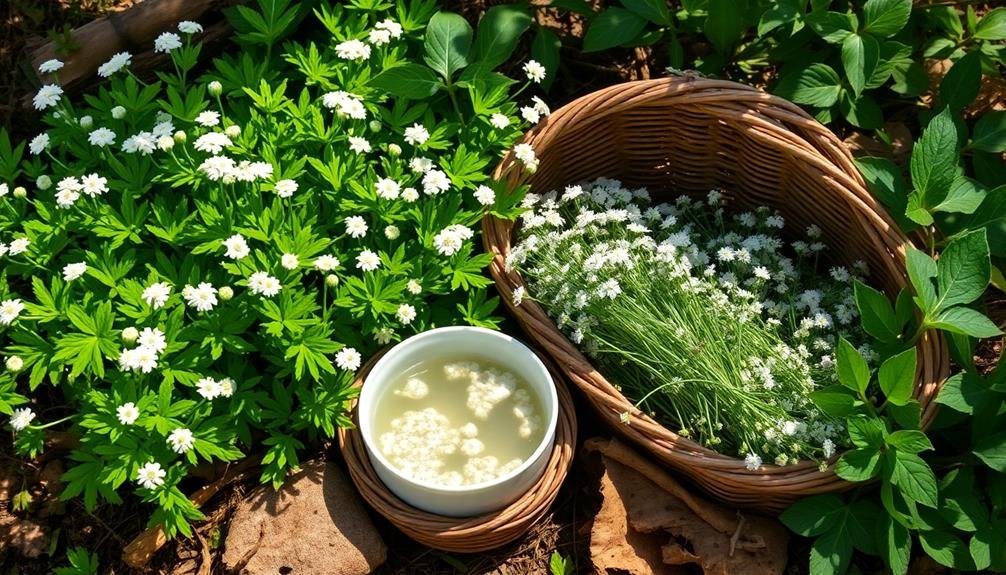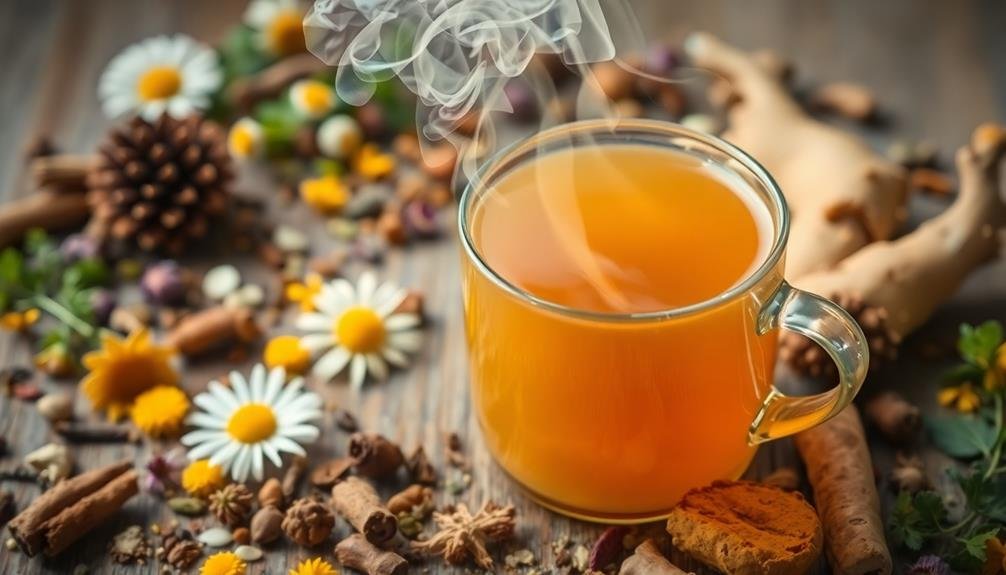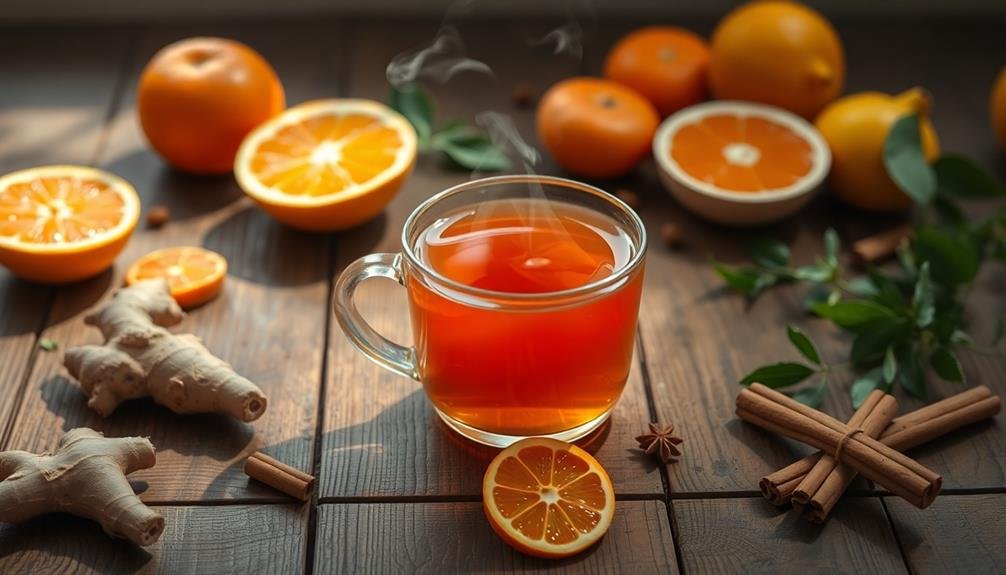Foraging yarrow for your natural tea blends is a great choice that boosts both flavor and health benefits. This herb is rich in antioxidants, supports your immune system, and has anti-inflammatory properties that can soothe digestive issues. Plus, it adds a unique taste with its slightly peppery undertones, which pair well with citrus and other herbs like mint. Whether you want to relieve stress or enhance your overall wellness, yarrow's calming effects can be a game-changer in your tea routine. Stick around to uncover more tips on how to maximize the benefits of this versatile herb!
Benefits of Foraging Yarrow

Foraging yarrow offers a wealth of benefits that can enhance your tea blends and overall well-being. This versatile herb is packed with antioxidants, which can help combat oxidative stress in your body. By incorporating yarrow into your tea, you're not just enjoying a unique flavor; you're also giving your immune system a boost.
Yarrow's anti-inflammatory properties make it an excellent choice for soothing digestive issues. If you've ever felt bloated or uncomfortable after a meal, a warm cup of yarrow tea can provide relief.
Plus, its calming effects can help reduce stress, making it a perfect addition to your evening ritual.
When you forage yarrow, you're connecting with nature and embracing a sustainable practice. It's a rewarding experience that allows you to appreciate the earth's bounty while crafting your unique tea blends.
You'll also find that yarrow pairs well with other herbs, such as chamomile or mint, creating delightful combinations for any occasion.
Identifying Yarrow in the Wild
When you're out exploring nature, spotting yarrow can be a rewarding experience. This herb thrives in sunny, open areas, often found in meadows, along roadsides, or in fields. To identify yarrow, look for its distinct features: tall stems, feathery, fern-like leaves, and clusters of small, white to pale yellow flowers.
Here's a quick reference table to help you recognize yarrow:
| Feature | Description | Notes |
|---|---|---|
| Leaves | Fern-like, deeply cut, and green | Grows up to 12 inches long |
| Stem | Tall, erect, and usually hairy | Can reach heights of 2-3 feet |
| Flowers | Small, white clusters, flat-topped | Blooms from late spring to fall |
| Aroma | Strong, herbal scent | Similar to chamomile when crushed |
As you hike, keep an eye out for these characteristics. Yarrow's unique appearance makes it easier to spot among other plants. By becoming familiar with its features, you'll enhance your foraging experience and guarantee you're identifying yarrow correctly in the wild. Happy foraging!
Harvesting Yarrow Sustainably

Once you've identified yarrow in the wild, it's important to harvest it sustainably to assure the plant remains healthy and abundant for future foragers.
Start by choosing only a few plants in a given area rather than depleting one spot. This way, you allow the yarrow to continue growing and thriving.
When harvesting, only take a small portion of the leaves and flowers—ideally around one-third of the plant. This practice assures that the yarrow can regenerate and maintain its natural ecosystem.
Use sharp scissors or shears to make clean cuts, minimizing any damage to the plant. Avoid uprooting the entire plant, as this can hinder its ability to recover.
Also, be mindful of the environment around you. Stay on established paths to reduce soil compaction and avoid trampling other plants.
If you're foraging in a sensitive area, consider the impact of your actions and take only what you need.
Lastly, always take a moment to express gratitude for the gift of nature. By harvesting responsibly, you not only enjoy yarrow's benefits but also help preserve it for others and future generations.
Preparing Yarrow for Tea
After harvesting yarrow, preparing it for tea is a straightforward process that enhances its flavor and benefits. Begin by rinsing the yarrow under cool water to remove any dirt or insects. Next, chop the leaves and flowers into smaller pieces, which allows for better extraction of flavors during brewing. You can use fresh yarrow or dry it for later use. To dry, simply spread the chopped yarrow in a single layer on a clean surface, away from direct sunlight, until completely dry.
Here's a simple guide to help you prepare yarrow for tea:
| Step | Action | Notes |
|---|---|---|
| Rinse | Clean the yarrow | Use cool water |
| Chop | Cut into smaller pieces | Helps with flavor extraction |
| Dry (if needed) | Spread out in a single layer | Keep away from direct sunlight |
Once you've prepared your yarrow, you can steep it in hot water for about 5-10 minutes, depending on how strong you like your tea. Enjoy your freshly brewed yarrow tea, knowing you've maximized its potential!
Flavor Profiles and Pairings

When you taste yarrow, you'll notice its unique herbal notes that can bring depth to your tea blends.
To enhance its flavor, consider pairing it with complementary herbs like mint or chamomile.
Seasonal ingredients can also elevate your blend, making for a revitalizing drink year-round.
Yarrow's Unique Flavor Notes
Although often overlooked, yarrow brings a unique complexity to tea blends that can elevate your brewing experience. Its flavor profile is a delightful mix of earthy, herbal notes with a hint of bitterness, reminiscent of chamomile but with a sharper edge. When you sip yarrow tea, you'll notice a subtle floral quality that adds depth, making it an intriguing choice for those seeking something beyond traditional herbal teas.
Yarrow's unique taste pairs beautifully with a variety of other herbs and flavors. You might find that its slightly peppery undertones complement citrusy fruits, enhancing the overall brightness of your blend. Try adding lemon or orange zest for an energizing twist.
Additionally, yarrow's robust character stands up well to richer flavors like ginger or cinnamon, allowing you to create warming blends perfect for colder months.
Experimenting with yarrow in your tea can bring a rejuvenating change to your usual routine. As you explore its potential, you'll discover how this humble herb can transform your tea experience, making each cup a celebration of unique flavors and aromatic notes.
Ideal Complementary Herbs
What herbs can truly enhance yarrow's distinct flavor? When crafting your tea blends, consider incorporating chamomile. Its sweet, apple-like notes blend beautifully with yarrow's earthy undertones, creating a soothing experience.
Another great option is peppermint. The cool, invigorating taste of peppermint can balance yarrow's slightly bitter profile, adding a bright zing that awakens the palate.
You might also explore combining yarrow with lemon balm. This herb offers a gentle citrusy sweetness that complements yarrow's herbal depth, making for a wonderfully aromatic tea.
If you're looking for a touch of spice, don't overlook ginger. A small amount of ginger can add warmth and complexity, enhancing yarrow's flavor while providing additional health benefits.
Seasonal Flavor Pairing Ideas
With yarrow's unique flavor profile in mind, seasonal flavor pairings can elevate your tea blends throughout the year.
In spring, pair yarrow with fresh mint and lemon verbena for a revitalizing herbal blend that captures the essence of renewal. The bright, grassy notes of yarrow complement mint's coolness perfectly.
As summer rolls in, consider blending yarrow with hibiscus and dried strawberries. This combination creates a vibrant, fruity tea that's both tart and floral, ideal for iced variations.
In autumn, yarrow marries well with warming spices like cinnamon and ginger, creating a cozy blend that's perfect for chilly evenings.
Winter calls for deeper flavors, so try yarrow with roasted chicory and orange peel. This mix offers a rich, grounding experience, balancing yarrow's herbal notes with sweet citrus.
Each season presents an opportunity to explore new combinations, enhancing your tea's complexity.
Health Benefits of Yarrow Tea
Yarrow tea isn't just a flavorful addition to your blends; it also offers impressive health benefits.
It can help boost your immune system and aid digestion, making it a great choice for overall wellness.
Immune System Support
While many herbs offer health benefits, yarrow tea stands out for its potential to support the immune system. This remarkable herb has been used for centuries, and its properties can help you maintain a stronger defense against illness.
Here's how yarrow tea can enhance your immune health:
- Anti-inflammatory properties: Yarrow contains compounds that may reduce inflammation, which can help your immune system function more efficiently.
- Rich in antioxidants: The antioxidants found in yarrow tea can combat free radicals, protecting your cells and supporting your body's defenses.
- Aids in fever reduction: Yarrow has traditionally been used to promote sweating, which can help lower fevers and assist your body in fighting off infections.
- Supports respiratory health: Drinking yarrow tea may help clear mucus and phlegm, making it easier for you to breathe and potentially reducing the risk of respiratory infections.
Incorporating yarrow tea into your daily routine could be a simple yet effective way to bolster your immune system.
Digestive Aid Properties
Beyond supporting your immune system, yarrow tea also offers impressive digestive aid properties. When you sip on this herbal infusion, you're not just enjoying a comforting beverage; you're also helping your digestive system function better. Yarrow can alleviate bloating, gas, and indigestion, making it a great choice after a hearty meal.
Here's a quick overview of yarrow's digestive benefits:
| Benefit | Description |
|---|---|
| Relieves Bloating | Helps reduce the feeling of fullness. |
| Eases Indigestion | Promotes easier digestion of food. |
| Reduces Gas | Minimizes uncomfortable gas buildup. |
| Stimulates Appetite | Encourages a healthy desire to eat. |
| Soothes Stomach Cramps | Calms discomfort from cramps or spasms. |
Incorporating yarrow tea into your routine can be a simple yet effective way to support your digestive health. Whether you brew it alone or blend it with other herbs, you'll find that its natural properties can enhance your overall well-being. Next time you're feeling a bit off after a meal, consider reaching for a warm cup of yarrow tea to help set things right.
Frequently Asked Questions
Can Yarrow Be Used in Cooking or Only for Tea?
Yarrow isn't just for tea; you can use it in cooking too! Its leaves and flowers add a unique flavor to dishes, salads, and soups. Just remember to use it sparingly for the best taste!
How Do I Store Harvested Yarrow for Later Use?
To store harvested yarrow, dry the leaves and flowers by hanging them upside down in a cool, dark place. Once dried, place them in an airtight container away from light to preserve freshness.
Is Yarrow Safe for Children and Pets?
Yarrow's generally safe for children and pets, but it's best to consult a healthcare provider or veterinarian first. You should always guarantee proper identification and avoid excessive amounts to prevent any potential adverse effects.
What Time of Year Is Best for Foraging Yarrow?
The best time for foraging yarrow is late spring to early summer. During this period, you'll find the plants vibrant and abundant, making it easier to gather fresh, potent leaves and flowers for your needs.
Can I Find Yarrow in My Backyard or Local Parks?
You can often find yarrow in your backyard or local parks. It thrives in sunny areas and well-drained soil. Just look for its feathery leaves and clusters of small white flowers blooming during summer.
In Summary
Foraging yarrow for your natural tea blends is a rewarding experience that connects you with nature while enhancing your wellness routine. By identifying, harvesting, and preparing yarrow sustainably, you can enjoy its unique flavor and numerous health benefits. Whether you sip it solo or blend it with other herbs, yarrow can elevate your tea game. So, grab your basket and start foraging—you'll discover a world of flavors and benefits waiting for you!





Leave a Reply